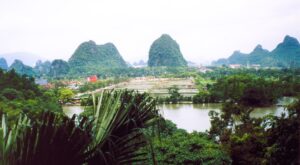
China is the ultimate country to explore the future and the ancient past simultaneously. Discover its storied past as one of the great cradles of civilization. Experience its rapidly changing modern cities and groundbreaking innovations. While you’re here, don’t miss out on Hong Kong, a true bridge between east and west. Get to know the people and their wildly diverse cultures and even languages.
Must Sees: Beijing | Must Sees: Xi’an | Must Sees: Shanghai | Must Sees: Nanjing | Must Sees: Wuxi | Must Sees: Suzhou | Must Sees: Hangzhou | Must Sees: Xiamen | Must Sees: Yongding | Must Sees: Guangzhou | Must Sees: Macau | Must Sees: Guilin | Must Sees: Kunming | Must Sees: Dali | Must Sees: Lijiang | Must Sees: Leshan | Must Sees: Chengdu | Food
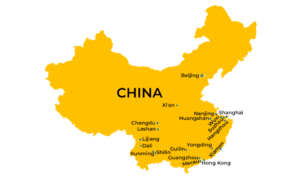
MUST SEES: BEIJING
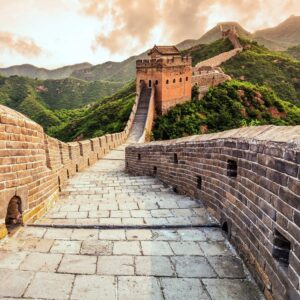
Great Wall
China’s first emperor built the wall 2,000 years ago. Spanning 13,170 miles, the fortifications were a defensive system between China’s agricultural society and nomads from the Eurasian Steppe. The wall stretches from the Gobi Desert in the west to Korea in the east.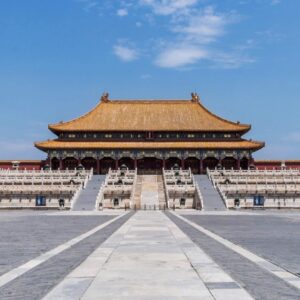
Forbidden City
The Forbidden City was the home of 24 Ming and Qing dynasty emperors. Its 9,999 rooms were restricted to the emperor, imperial family, and eunuchs. The Hall of Supreme Harmony has golden yellow tiles, 10 mythical creatures on the rooftop, and a Dragon Throne.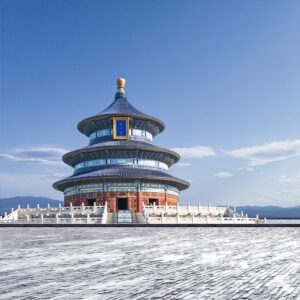
Temple of Heaven
The Hall of Prayer for Good Harvests is an impressive circular building with three blue gables built on three levels of marble. The structure contains colorful interlocking wooden beams with no nails. During annual rituals, the emperor worshipped the celestial order and prayed for good harvests.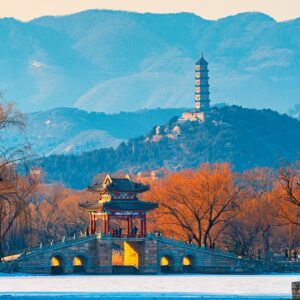
Summer Palace
The imperial garden by Kunming Lake has a collection of pagodas, gardens, and palaces. In 1898, Empress Dowager Cixi imprisoned a puppet emperor here. Spot the Marble Boat oddity, which doesn’t float and is wood painted to look like marble.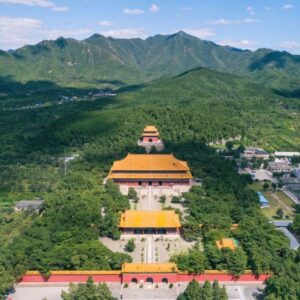
Ming Tombs
The Ming Tombs are the mausoleums of 13 Ming emperors. Go underground to Dingling’s mausoleum. He defied tradition and was entombed with his two empresses in the same vault. Minglou Tower stands tall in front of Changling’s mausoleum.
Peking Opera
Peking opera is a mix of music, singing, martial arts, dance, and acrobatics. Catch a performance at the Liyuan Theatre for a classic introduction to Peking Opera.
MUST SEES: XI’AN

Terracotta Army
An army of soldiers and horses defends Qin Shi Huang, China’s first emperor, in the afterlife. Artisans carved different faces for each of the 8,000 soldiers, charioteers, and acrobats. When archeologists excavated the terracotta in 1974 after 2,000 years, the paint flaked off in minutes.
Big Wild Goose Pagoda
Big Wild Goose Pagoda is a seven-story, rammed earth tower with a stone façade. The monk Xuanzang spent 17 years in India and brought back Sanskrit Buddhist texts. The pagoda once stored these texts and statues of Buddha.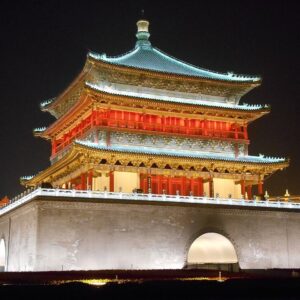
Bell Tower
Take a walk on an elevated walkway. Xian’s ancient city wall has 8.7 miles to explore. At night, the Drum Tower and Bell Tower are illuminated. These towers aren’t just gateways into the city. At the Bell Tower, there’s a log for ringing the giant Jingyun Bell.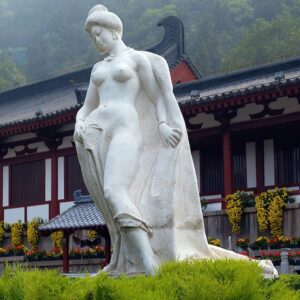
Huaqing
During the golden age of the Tang Dynasty, Xuanzong rebuilt Huaqing Palace. The great beauty Yang Guifei became Xuanzong’s favorite concubine at the geothermal pools. After the dynasty’s decline, Yang and her family were blamed and put to death.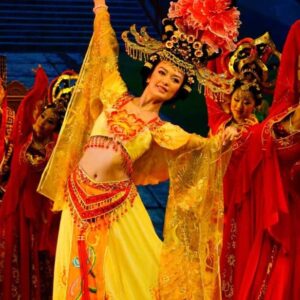
Tang Dynasty Show
Witness the culture of China’s golden age during the Tang Dynasty. The show begins with performances of ancient Chinese musical instruments while you enjoy a lavish meal. The dance segment is a spectacle of colorful costumes and graceful movements.
MUST SEES: SHANGHAI
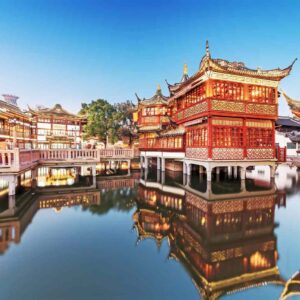
Yuyuan Garden
Yuyuan reflects classical garden design from the Ming Dynasty. Its pavilions, halls, and ponds offer a glimpse of the old city in the heart of a futuristic metropolis. Locals believe the nine-turn bridge prevents spirits from entering. Luckily, it leads to the bazaar’s souvenirs and snacks.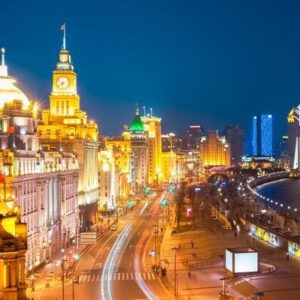
The Bund
The Bund was a path for towing barges along the Huangpu River. After the Opium War, Western nations operated banks in glamorous Art Deco buildings. Now you can visit restaurants and hotels on the glitzy waterfront.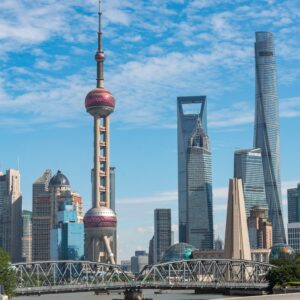
Oriental Pearl Tower
The Dongpo district houses Shanghai’s modern skyscrapers, such as the Shanghai World Financial Center and Shanghai Tower. The Oriental Pearl Tower stands out next to these hi-tech structures. The tower contains 15 observation levels including 11 pearls.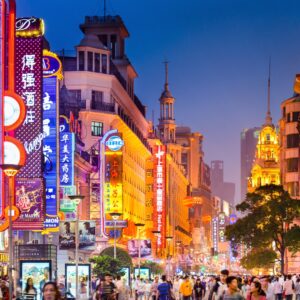
Nanjing Lu
Nanjing Road is one of the world’s busiest shopping streets. At night, it’s great for people watching or gazing at neon.
Shanghai Museum
In the shape of a ding, an ancient cauldron, Shanghai Museum displays extensive collections of China’s cultural and artistic heritage. The bronze gallery contains numerous dings, rice vessels, and bells. The ceramics gallery contains tri-colored Sangcai horses and Sogdian figures.
Jade Buddha
The Jade Buddha Temple is a Buddhist temple with two jade Buddha statues from Myanmar. The large pale-green jade Buddha is sitting in lotus pose at over six feet tall and three tons. The small white jade reclining Buddha depicts the Buddha’s death.
MUST SEES: NANJING

Sun Yat-sen Mausoleum
In 1911, Sun Yat-sen led a revolution that overthrew the Qing Dynasty and became the first president of the republic. After the blue triple-arched entrance, a grand staircase leads to the marble hall’s circular vault.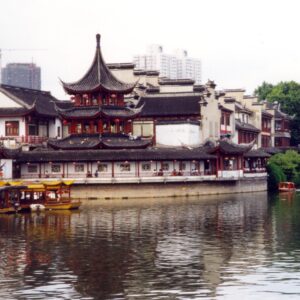
Confucian Temple
Many scholars studied at the temple to prepare for imperial service exams. People also worshipped Confucius and learned about his philosophies. You can take a short cruise on Qinhuai River next to Fuzimao.
Linggu Pagoda
The nine-story Linggu Pagoda is impressive. During your climb up a spiral staircase, there are doorways allowing you walk around the eight circular balconies. The pagoda commemorates soldiers who died during the Northern Expedition in 1926 against warlords in an attempt to reunify China.
MUST SEES: WUXI
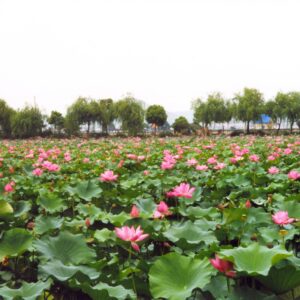
Liyuan Garden
Liyuan is on the shore of Li Lake. Fan Li was a senior minister who retired here after conquering the state of Wu. The garden contains beautiful pink lotus blossoms. You can even make a hat out of the giant green lotus leaf.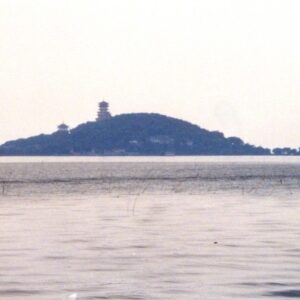
Lake Taihu
Taihu is a freshwater lake by Suzhou, Wuxi, and the Grand Canal. You can take a boat ride on Taihu and spot the flags marking the oyster beds. The lake has many islands, including Turtle Head Isle, which resembles a turtle head. Local bandits used to hide at the Sanshan Islands.
MUST SEES: SUZHOU

Grand Canal
Go on a cruise of the major shipping lane next to freighters transporting rice and watermelons. Observe small homes at the canal’s edge where villagers wash their laundry. Pedestrians and bikes cross the canal on bridges with grooves for carts.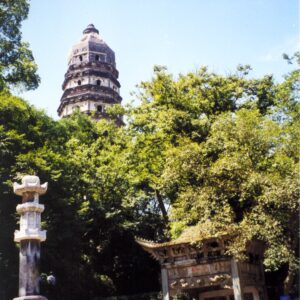
Tiger Hill
According to legend, King Helu of Wu was buried underwater with 3,000 swords and guarded by a mysterious white tiger. Stones inscribed with ancient fables line the path. An emperor sharpened his sword in the Sword Stone 1,000 years ago. The octagonal seven-story pagoda has a noticeable tilt.
Humble Administrator’s Garden
Scholars built classical gardens in Suzhou as places to reflect and relax. Wang Xianchen was a Ming Dynasty official who built this garden after retiring. The garden mimics landscapes of rocks, hills, and rivers.
MUST SEES: HANGZHOU
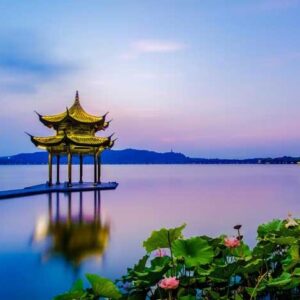
West Lake
Take a cruise of peaceful West Lake. See for yourself the scenery that has captivated so many poets and painters. West Lake is the source of inspiration for classical Chinese garden designers.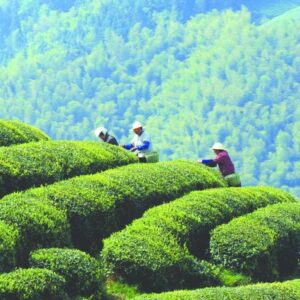
Longjin Tea
Explore the Longjin village and tea plantations. Watch how freshly picked tea leaves are slowly roasted on a pan. The illustrious Dragon Well tea leaves have a jade color, rich aroma, chestnut flavor, and feather shape. Sample the fragrant dragon well tea at the source.
Lingyin Temple
An Indian monk, Matiyukti, made the Temple of the Soul’s Retreat. See rocky grottoes with carvings from the Journey to the West. The Grand Hall of the Great Sage has a tranquil setting with trees and wisps of incense. In the hall, check out the gold Sakyamuni Buddha.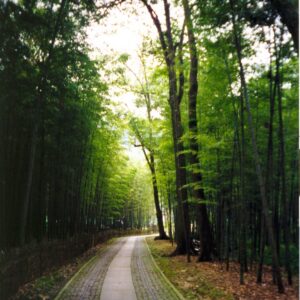
Yunxi Bamboo Forest
Soaring green stalks gently sway in the wind. Yunxi means clouds lingering, which is fitting as beautiful bamboo thickets dance in the misty air. Walk on the winding path and listen to gentle rustling sounds.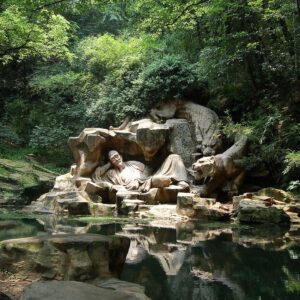
Running Tiger Spring
Step into Running Tiger Spring’s dreamy hillside. Long ago, a crazy monk named Ji Gong was about to leave a temple due to lack of water. That night he dreamed two tigers were running and kicking up dirt at this spot. When he woke up, he was lying next to a spring.
MUST SEES: XIAMEN

Gulangyu
Gulangyu is an island off Xiamen’s coast. This pedestrian-only island is a ferry ride from the mainland. On a hill, Zheng Chenggong’s statue peers across the sea. Zheng was a Southern Ming general who resisted Qing conquest and liberated Taiwan from the Dutch.
Sunlight Rock
Sunlight Rock is the highest point of Gulangyu Island at the southern tip. After a quick walk to the peak, there’s a great view of Gulangyu and Xiamen’s coastline.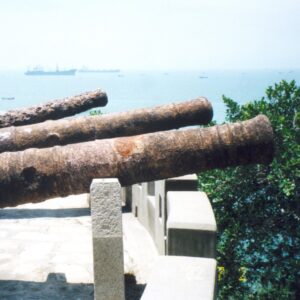
Hulishan Fortress
Hulishan Fortress is a defensive installation on the south of Xiamen Island. The German-made cannon protects Xiamen from a sea invasion with a range of 10 miles. At the Rongguan museum below, there’s a pork stone that looks like a thick slab of bacon.
MUST SEES: YONGDING
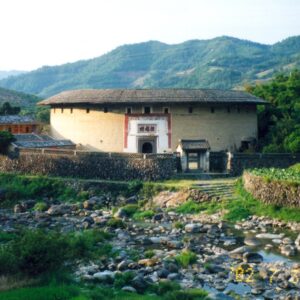
Tulou
Stay at a tulou with the hospitable Hakka in the idyllic Yongding highlands. A tulou is a mysterious earthen house next to streams and mountains. The Hakka people built the architectural marvels for defensive and agricultural purposes.
MUST SEES: GUANGZHOU
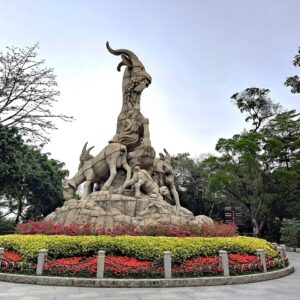
Yuexiu Garden
Guangzhou’s Legend of the Five Goats goes back 3,000 years. A drought lasted many years and food was scarce. Then one day, a five-colored cloud floated from the sea. Five gods wearing different colors rode five goats. From then on, the people had rich harvests and the goats turned into stone.
MUST SEES: MACAU
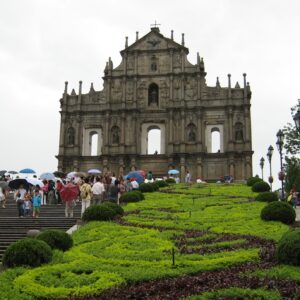
Ruins of St. Paul’s
The façade is all that’s left of the Church of St. Paul. Chinese and Japanese craftsmen built the Portuguese church in the 17th century. Carvings of guardian lions and a hydra adorn the Baroque front. In 1835, a fire burned nearly everything.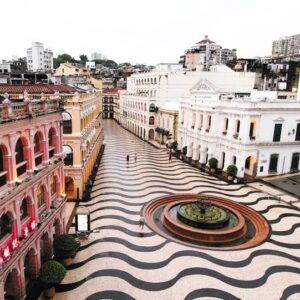
Senado Square
Senado Square was Macao’s gathering spot for its Chinese, Portuguese, and Macanese communities. Portuguese pavement covers the plaza in wavy black and white patterns while pastel Neoclassical buildings surround the square.
Grand Lisboa
The former colony is the world’s opulent gambling capital. Big name operators such as Wynn, the Venetian, and MGM have glittering gaming palaces. The Grand Lisboa towers over the skyline with a gold blossoming lotus flower. From certain angles, it looks like an imminent alien invasion.
MUST SEES: GUILIN
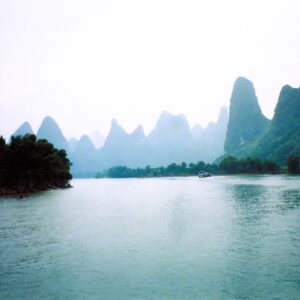
Li Jiang Cruise
Leap into a classic Chinese landscape painting and admire magnificent limestone peaks that resemble rhino horns. Nine Horses Fresco Hill is a big canvas with equine lines. Some karst pinnacles have undulating cones, while others are isolated towers.
Elephant Trunk Hill
Elephant Trunk Hill looks like an elephant with its trunk drinking water out of the Li Jiang River. There are people taking rides on pole boats with their feet splashing in the water. There are also kids swimming around the trunk.
Reed Flute Cave
This is a subterranean realm of stalagmites and stalactites. One charmed stalactite was the Monkey King’s magic spear. The cave’s name refers to the reeds growing at its base, which are made into flutes. Today, art and technology present the cave in a colorful light.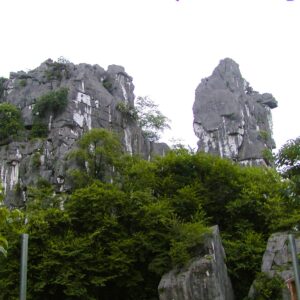
Seven Star Park
Seven Star Park has something for everyone. Explore waterfalls flowing from limestone peaks. Enjoy a cool breeze in a cave. Little ones will appreciate the zoo’s tiger cage. See the fascinating shapes at Camel Hill.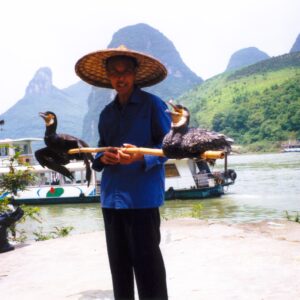
Yangshuo
Yangshuo is a small river town with a carefree attitude that’s a haven for foreign backpackers and banana pancakes. There are still fishermen who use cormorants. The sleek black birds dive and use their powerful beaks to catch prey. Everyone wins with little fish for the cormorants and big fish for the fishers.
MUST SEES: KUNMING
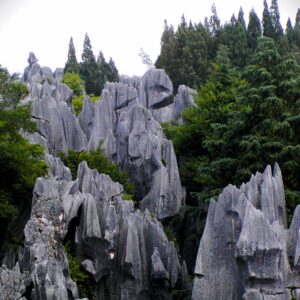
Shilin
The Stone Forest is a garden of limestone formations that resembles a forest of petrified trees. The grayish charcoal hoodoos inspire visions of camels, puppies, queens, elephants, and sugar plum fairies. When the sunlight peeks through the clouds, the rocks look shiny and metallic.
MUST SEES: DALI
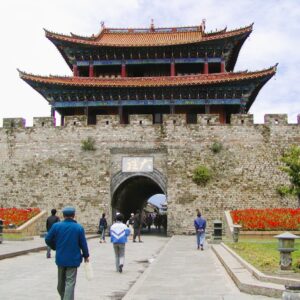
South Gate
The Ming Dynasty built a city wall during their occupation of Dali in the 14th century. The South Gate is an entrance to Old Town. Dali is blessed with natural beauty with Cangshan’s 19 peaks and Lake Erhai. In addition, Yunnan Province’s climate is like spring all year.
Old Town
The Bai people settled here 3,000 years ago. They are one of China’s 56 ethnic minorities. The Old Town was the capital of the Nanzhao Kingdom and then the Dali Kingdom. It was also at a crossroads between India, Tibet, and China.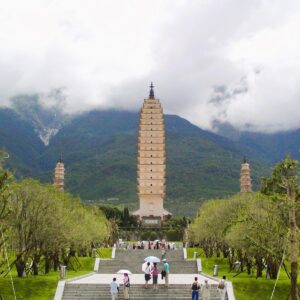
Three Pagodas
Walk from Old Town past corn fields to the Three Pagodas. Qianxun Pagoda is the tallest with 16 levels. The flanking pagodas are octagonal with 10 levels. Each pagoda has a Buddha statue at each side of every story. There is a reflecting pool behind the pagodas.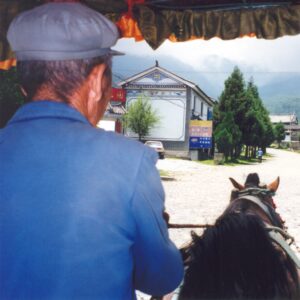
Horse and Buggy
For a change of pace, tour Erhai Lake in a horse and buggy. The horse steadily plods along the back roads outside Dali. On rocky paths climbing uphill, the buggy gently rocks back and forth.
Cangshan Mountain
Take Gantong cableway to Cangshan. A giant xiangqi chessboard depicts a scene from Ji Rong’s legendary wuxia martial arts novel. Climb over Qingbixi stream on a suspension bridge. You’ll see a crystal-clear teal pool with a Buddhist sculpture. But, watch out for mischievous monkeys.
MUST SEES: LIJIANG

Old Town
Lijiang is an idyllic town caught in a time warp. Zigzag aimlessly through an ancient labyrinth of canals, plank bridges, silver cobblestones, and crooked streets. Meet the Naqxi people, a matriarchal society with their own Dongba hieroglyphic script.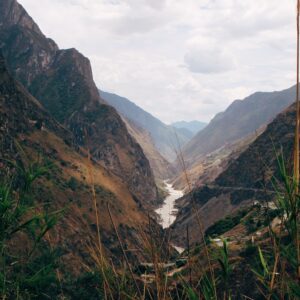
Tiger Leaping Gorge
What a gnarly name! A tiger leaped across the Yangtze. Trek the gorge and stay at guesthouses for creature comforts. The 18-mile hike has 8,569 feet of elevation gain, thrilling scenery, and views of Jade Dragon Snow Mountain.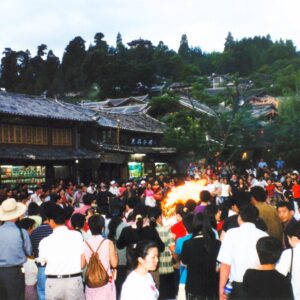
Bonfire
On some nights, there is a festival where everyone gathers around the Sifang plaza. The Naqxi light a bonfire and hold song and dance performances. When the Old Town finally goes dark, you may see little baskets with candles floating in the canals.
MUST SEES: LESHAN

Giant Buddha
In 723 AD, a Buddhist monk, Hai Tong, started construction on the monument. Seventy years later, his disciples finished carving the statue out of Qifeng Peak’s red sandstone. Climb the staircase to get better views of the statue’s vegetation. At the top, you can see the back of the Buddha’s enormous bumpy head.
MUST SEES: CHENGDU

Panda Base
The panda base is a research and breeding facility dedicated to conservation of giant pandas and other endangered animals. Go visit the cute and cuddly pandas in a natural setting. Watch the gentle giants roll around and wrestle on a grassy hill or climb trees.
FOOD

Peking Duck
Peking Duck is an imperial roast duck dish. Thin slices of crispy duck skin and meat fill a crepe pancake, along with scallions, cucumbers, and sweet bean sauce. Beijing’s Quanjude has been artfully carving duck tableside since 1864.
Xiao Long Bao
Soup dumplings have wrappers as thin as gossamer with a pork filling. Eat carefully and slurp up the hot liquid before dunking in vinegar and chili crisp. In Shanghai, enjoy a bamboo basket of xiao long bao for breakfast.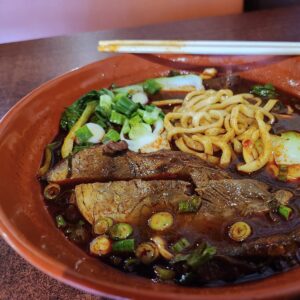
Beef Noodle Soup
Dense and elastic, hand-pulled noodles take center stage. A noodle puller gracefully stretches the dough. Thwack! The noodles pound the counter and a flour mist rises. The soup earns its flavor through slow simmering of the tender beef.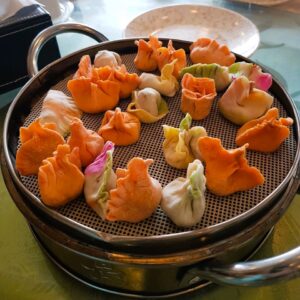
Dumpling Banquet
Don’t leave Xi’an without experiencing the dumpling banquet at Defachang. Choose from hundreds of different dumplings in an assortment of shapes, sizes, colors, and fillings. The jiaozi dumplings are shaped like swans, fish, flowers, rabbits, and walnuts.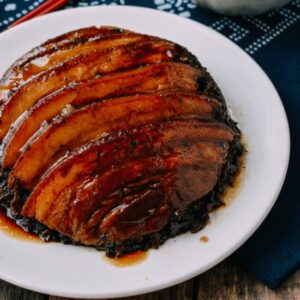
Pork Belly and Mustard Greens
In Fujian Province, the Hakka people make this rustic yet delicious dish of pork and mustard greens. The pork belly is cut into long thick strips and then braised. The preserved mustard greens are steamed.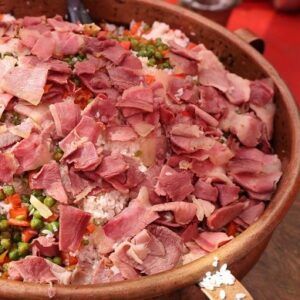
Xuanwei Ham
Xuanwei ham is from a specific breed of black pig and is incredibly aromatic, tender, and faintly sweet. Sliced thin, it’s on par with jamón Ibérico or prosciutto. By the canals in Lijiang, look for a restaurant serving claypot rice and Xuanwei ham.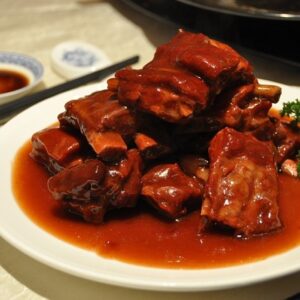
Wuxi Spareribs
When in Wuxi, try the Wuxi spareribs. The combination of soy, vinegar, ginger, and sugar makes these fall-off-the-bone braised ribs sticky and juicy.
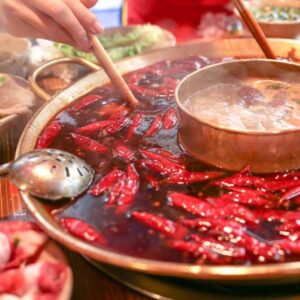
Sichuan Hot Pot
The brass pot bubbles and smokes with sizzling red-hot chili oil, floating peppers, and Sichuan peppercorns. The peppercorns create a mala effect of spiciness and numbing. Order a variety of meats, vegetables, and noodles to add to the broth. Soon, you’ll be a hot mess with tears and sweat in Chengdu’s 100-degree weather.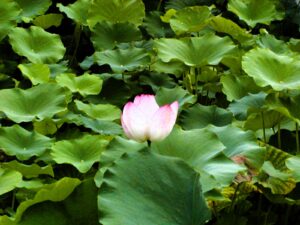
Regions
Africa | Antarctica | Asia | Australia | Europe | Middle East | North America | South America